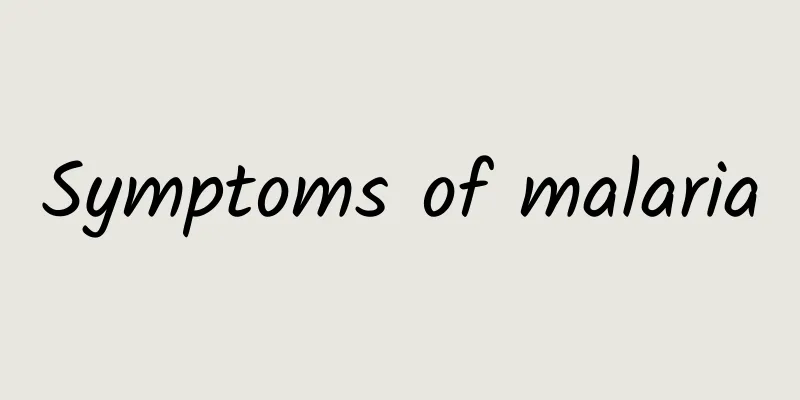Symptoms of malaria

|
When it comes to the disease of malaria, many people in reality may not know much about it. Most people have only heard of the name of this disease. Malaria is an infectious disease of our human body, usually caused by the bite of mosquitoes carrying the Plasmodium virus. The treatment of this type of malaria is relatively difficult. Therefore, understanding the relevant symptoms of malaria will be beneficial to the treatment of malaria. Malaria is actually not common in our human body. Of course, there are many people suffering from malaria, but it is not common in our lives, so most people will not be easily infected with malaria. Therefore, most people do not know much about the symptoms of malaria. So, in response to this situation, let’s talk in detail about the symptoms of malaria. Clinical manifestations 1. Incubation period The period from when a person is infected with Plasmodium to when they develop the disease (oral temperature exceeds 37.8°C) is called the incubation period. The incubation period includes the entire infrared period and the first reproductive cycle of the intraerythral period. The general duration of Plasmodium vivax malaria and Plasmodium ovale malaria is 14 days, that of falciparum malaria is 12 days, and that of Quarternary malaria is 30 days. Different amounts and strains of infectious protozoa, differences in human immunity, and different modes of infection can all result in different incubation periods. In temperate regions there are so-called long-latency strains, which can last up to 8 to 14 months. The incubation period of transfusion infection is 7 to 10 days. For fetal-transmitted malaria, the incubation period is even shorter. The incubation period may be prolonged for people with a certain level of immunity or who have taken preventive medication. 2. Chilling period Sudden chills, first in the extremities, then in the back and whole body. The skin has goose bumps, the lips and nails are cyanotic, the face is pale, and there are muscle and joint pains all over the body. Then the whole body starts to shiver and the teeth chatter. Some people cannot stop shaking even by covering themselves with several quilts. The shaking lasts for about 10 minutes or even an hour, and then the chills stop naturally and the body temperature rises. Patients often feel seriously ill during this stage. 3. Fever period After the feeling of cold disappears, the face turns red, cyanosis disappears, and the body temperature rises rapidly. Usually, the more obvious the coldness, the higher the body temperature, which can reach above 40°C. Patients with high fever suffer unbearable pain. Some tossed and turned restlessly, groaning incessantly; some were delirious, staring into space, or even convulsing or losing consciousness; some suffered from severe headaches and persistent vomiting. The patient has red face and shortness of breath; conjunctival congestion; burning and dry skin; rapid and strong pulse; and short and dark urine. They often complain of palpitations, thirst, and desire for cold drinks. It lasts for 2 to 6 hours, and sometimes even more than 10 hours. Herpes is common on the lips and nose after several attacks. 4. Sweating period In the later stage of high fever, there is slight sweat on the face and palms, which then spreads throughout the body. The sweat is profuse, and the clothes are soaked. The body temperature drops within 2 to 3 hours, often to 35.5℃. The patient feels comfortable but very sleepy and often falls asleep peacefully. After waking up, you will feel refreshed, your appetite will be restored, and you can go back to work as usual. This is the intermission period. There are many symptoms of malaria, which generally need to be distinguished into the incubation period, chill period, fever period and sweating period. The specific symptoms of the relevant periods have been introduced in detail in the above. Therefore, if you have the above-mentioned symptoms, you must go to the hospital for examination and treatment as soon as possible to protect your body's safety.
|
<<: Hyaluronic acid rhinoplasty sequelae
Recommend
What happens if you have severe hemorrhoids? What will the symptoms be?
Hemorrhoids are a common anorectal disease in lif...
Symptoms of blood-sucking bed bug bites
If you are bitten by a bed bug, it will often cau...
Is there a relationship between calcium deficiency and hair loss?
Calcium is an essential nutrient for our body. On...
How to clean the intestines before colonoscopy and pay attention to diet
Colonoscopy is a relatively routine physical exam...
Causes of lung nodules
I wonder if you have heard of pulmonary sarcoidos...
How much milk powder should a three-year-old baby drink
Babies cannot eat complementary foods after birth...
Effects and functions of chrysanthemum notoginseng
Chrysanthemum notoginseng, also known as Tu Panax...
Transparent blisters on the inside of the lower lip
I believe many people have experienced lip bliste...
Is it normal to have insomnia during pregnancy?
I believe that many middle-aged people are troubl...
How to treat chronic pharyngitis? What are the treatments for chronic pharyngitis?
Chronic pharyngitis is a common disease, which is...
What causes pain in the liver area caused by hepatic hemangioma?
Pain in the liver area is a common symptom of hep...
Can kidney disease drink beer?
Most patients with kidney disease should pay atte...
The difference between closed comedones and fat particles
Sebaceous cysts and closed comedones are both rel...
Why are there so many melanin on children's teeth?
The appearance of some melanin on the teeth is of...
Can drinking milk really whiten your skin? How can you drink milk to whiten your skin?
Everyone knows that drinking milk is healthy, and...









